
Tips for Respiratory Protection and Safety
Respiratory protection is consistently in the top 5 of OSHA’s annual “Top Ten” violations list and approximately 5 million workers are at risk for exposure. Construction job sites can expose workers to many different types of airborne contaminants all of which pose potential health and safety hazards.
Some respiratory hazards act quickly, like carbon monoxide which can make you unconscious or kill you in minutes. Other respiratory hazards can take years to make you sick, like asbestos or silica, which can cause lung cancer decades after you breathe it in.
Examples of Respiratory Hazards are:
- lead dust and fumes from grinding, welding, cutting, or brazing surfaces coated with lead-based paint
- silica dust from cutting, drilling, abrading, or demolishing concrete
- solvent vapors from adhesives, paints, strippers, cleaning solvents, and spray coatings
- isocyanate (a family of highly reactive, low molecular weight chemicals) vapors from spray foam insulation and certain spray paints or coatings
General industry and Construction standards around respiratory protection are all designed to protect workers from inhaling harmful materials and keep workers safe.
Practice Prevention Before Protection
Optimally, it’s best to prevent exposure to airborne contaminants. Methods such as replacing an airborne hazard, using specific exhaust systems or ventilation, and limiting worker exposure by staggering work schedules are all good steps to take to mitigate exposure.
However, mitigation is not always practical. When elimination, ventilation and/or staggering schedules are not feasible or sufficient to reduce harmful exposure, workers should wear appropriate respiratory protection.
To be effective, respirators must be properly selected and the user fit tested. Workers must be trained and follow employer and manufacturer’s instructions for the proper use, inspection, maintenance, and storage of respirators. This includes proper donning and doffing procedures.
Make Sure You Have the Right Respiratory Protection Equipment
Respiratory equipment is considered a form of personal protective equipment (PPE). And like any other PPE, there are specific pieces of equipment for specific functions. It’s important to use the proper type of respiratory equipment for the particular airborne hazard. There is no one “universal” respirator that will protect against every hazard, so it’s important to make sure you are using the right one.
Employers need to provide respirators that are approved by the National Institute for Occupational Safety and Health (NIOSH) for use under the direction of a written respiratory protection program as required by the Occupational Safety and Health Administration (OSHA).
Different types of respirators, such as filtering facepiece respirators (FFRs), elastomeric half-mask respirators (EHMRs), elastomeric full-facepiece respirators, and half-mask, full-facepiece, and hood or helmet powered air-purifying respirators (PAPRs), can be used to protect workers from airborne contaminants.
Get With the Respiratory Protection Program
When respirators must be used on your job site, employers must have a Written Respiratory Protection Program. This program must meet the requirements of either the Federal OSHA or your State OSHA respiratory protection standard.
The OSHA standard requires employers to do the following:
- develop and implement a written respiratory protection program
- evaluate the respiratory hazards in the workplace
- provide worker medical evaluations and respirator fit testing
- select and provide appropriate respirators
- provide for the maintenance, storage, and cleaning of respirators
- provide worker training about respiratory hazards and proper respirator use
- evaluate workers’ use of respirators and correct any problems
- provide access to specific records and documents, such as a written copy of your employer’s respiratory protection program
A respiratory protection program must be managed by a qualified, trained safety professional who understands the ever-changing workplace requirements. This professional must continuously monitor the program and make sure workers are adequately protected. Further, the program administrator must know the OSHA Respiratory Protection Standard and must periodically evaluate the program and make any necessary changes.
Compliance Consultants, Inc. can provide your organization with safety assessments and respiratory protection plans to help not only mitigate respiratory risks, but also advise on the proper respiratory protection equipment (PPE) to use for a specific situation.
Contact us at 610-237-7100
Resources:
https://www.osha.gov/respiratory-protection
OSHA Video
https://www.osha.gov/video/respiratory-protection/construction
Watch the OSHA Respiratory Protection in Construction video here:



